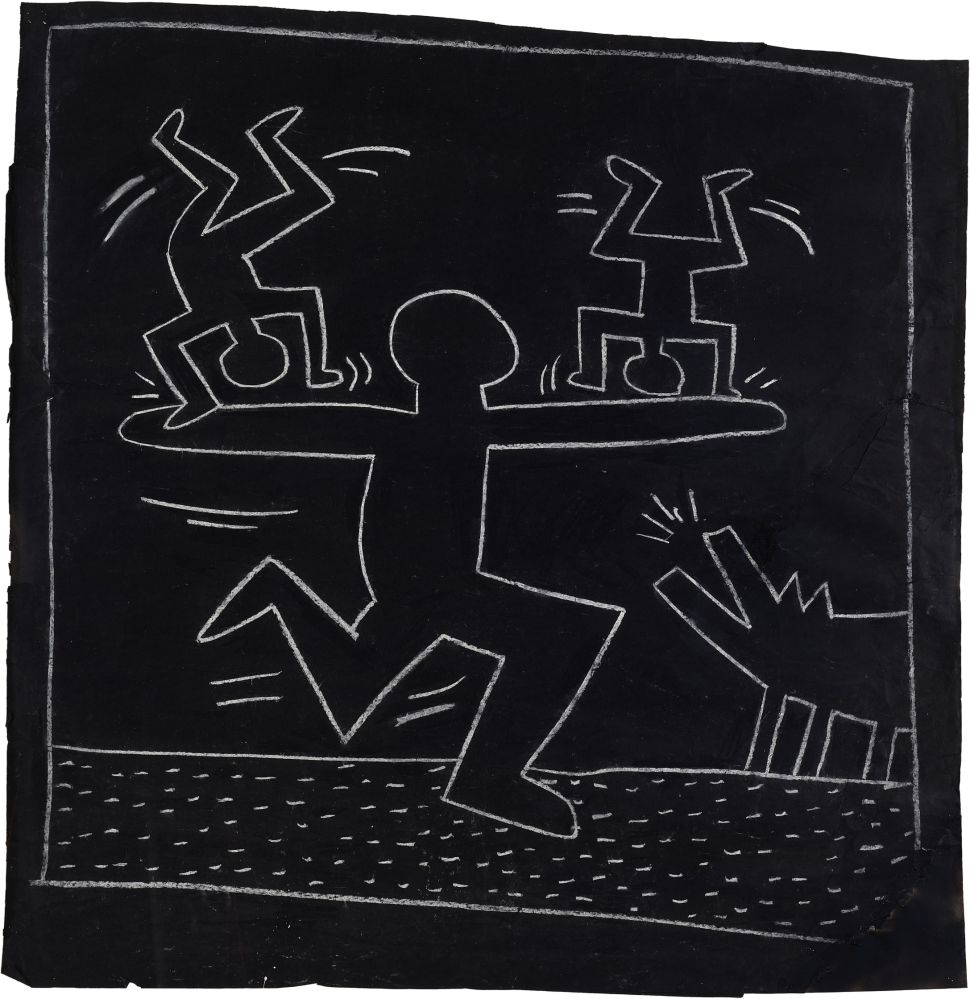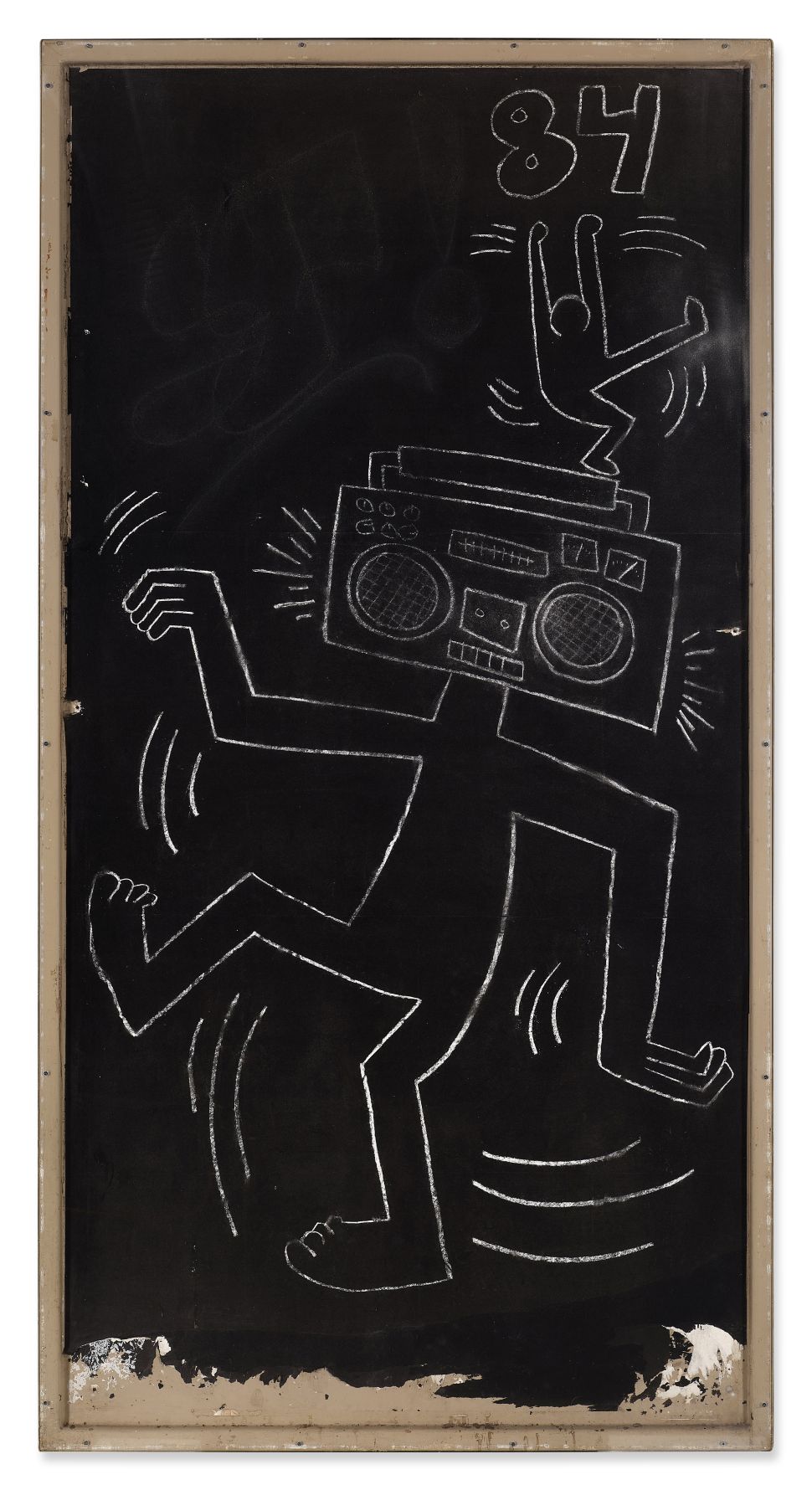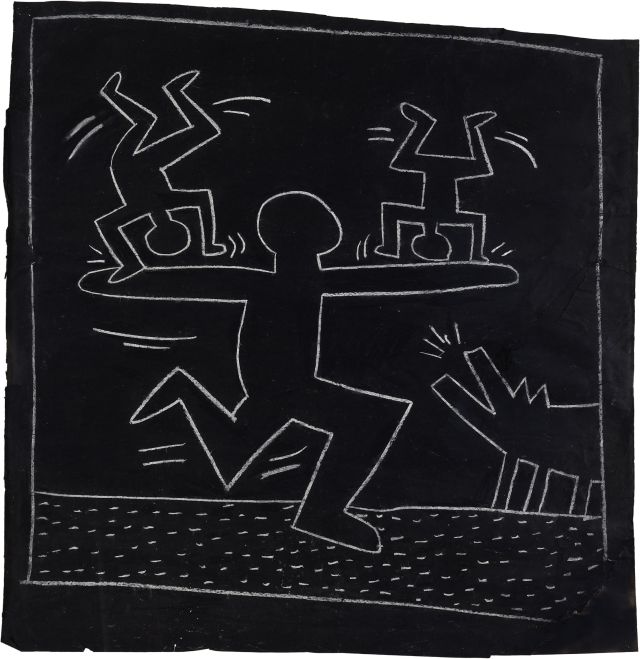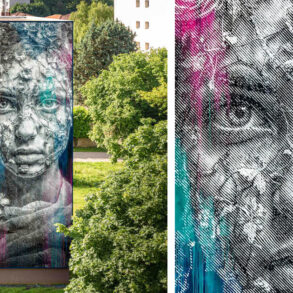
As the November marquee auction season approaches and the major auction houses start to build momentum by revealing their top lots, the search for who has consigned what and why begins. Provenance, as we know, can play a big part in establishing and validating an artwork’s value, whether by sparking renewed interest, providing reassurance to buyers or adding art historical context. Sotheby’s, for its part, just announced that a group of thirty-one rare Keith Haring subway drawings will star in the Contemporary Day Sale on November 21 with a combined estimate of between $6.3 and $9 million. This is a very exciting moment for Haring’s collectors as none of these works have ever been offered at auction before, and it’s very difficult to find the originals in such well-preserved condition.
Haring came from a family of modest means in Pennsylvania. His father was an amateur cartoonist who, from his early years, encouraged Keith to invent his own characters. Haring’s talent for drawing led to his receiving a scholarship to attend the School of Visual Arts in New York City, where he studied semiotics, but it was his contact with the copious street art that was everywhere in 1980s New York that inspired him most.
Haring started drawing in the subway just as a hobby while en route to work: noticing that the MTA covered unpaid advertisements with black matte paper, he began scrawling his inventive visual language on them in white chalk. In short order, his unique and highly recognizable style attracted his first fans. Nonetheless, Haring continued his drawings in front of the crowds and the NYPD, who ticketed and even arrested him for vandalism over the next five years. Describing them in an essay published for Art in Transit: Subway Drawings, published in 1984, he said felt that his work was “more of a responsibility than a hobby,” a way to leave a critical trace as an individual presence in a cannibalizing metropolis dominated by corporate interests and unstoppable real estate speculation and gentrification. Even when Haring’s career skyrocketed and he established himself as a leading figure in the downtown art scene, he said the subway was still his “favorite place to draw.”
SEE ALSO: ‘Party of Life’ Is a Celebration of Warhol, Haring and 1980s New York City in Munich
During his subway project, he appropriated thousands of black panels for energetic mark-making to build an inventory of iconic images, such as his nuclear dogs, angels, flying saucers, babies, smiley faces, etc.—the motifs mostly engineered at his seminal creative haunt, Club 57. “I think the origin of the subway drawings was part of how they came about in a sense, where it was part of Keith’s DNA,” Gil Vazquez, executive director of the Keith Haring Foundation, said in a statement. “There’s a significant component of generosity. When I think of the subway drawings, I think of them as one of Keith’s first acts of activism.”
Given the nature of urban guerrilla art, most of the subway drawings have been lost or destroyed, making the ones coming to auction a true rarity for fans and institutions looking to add to their collections. Because of their importance and rarity, the works have also been included in prominent exhibitions, including the Brooklyn Museum’s 2012 critically acclaimed exhibition of Haring’s career titled “Keith Haring: 1978-1982,” which marked the last occasion the group exhibited together. Most of the works coming to auction have a long exhibition history, like Untitled (Still Alive in ’85), which is one of the final subway drawings and has been featured in many prominent exhibitions at MoMA, the Reading Public Museum in Pennsylvania, Musee d’Art moderne de la Ville in Paris, de Young Museum in San Francisco and the Kunsthalle der Hypo-Kulturstiftung in Rotterdam.

Behind their extraordinary survival is a passionate art collector, Larry Warsh, who has taken on stewardship of these thirty-one works for nearly 40 years, building the most exceptional and extensive assemblage of Haring’s subway drawings in private hands. Observer spoke with Wash to understand how those gems came into his collection, the importance of preserving these drawings and, more generally, what’s in his art collection today.
“I’ve been collecting Keith Haring since the mid-’80s, and collecting all kinds of artwork all along, drawings, subway drawings, even a car, anything to do with Keith that was very compulsive at the time,” Warsh told Observer. Arguably, the collector was one of the first supporters of Keith Haring, despite the fact that he doesn’t see himself as a patron in traditional terms. “I was a patron for him in supporting his creative self, what he stood for and what he did. I was not a traditional patron; I just gave money or attended all the gallery functions. I was more pure in the sense of seeing his creativity and what he was doing then. It was a different time.”
Warsh is also an art historian, having published three books about Keith Haring. When asked how he spotted Haring’s talent so early and realized that his work would have historical relevance, he demures. “First of all, it was him, as a creative being and a person. Wherever he drew as artwork, his energy and translation of symbols and signs were unique, and most people would feel comfortable looking at his art. It was art for everyone. He made art for everybody, and he was a generous person and cared about people; he cared about causes; he cared about kids.”
Those subway drawings were part of his tridimensional works—Warsh is currently writing a book on this—and link him to the notion of the Duchampian ready-made, bringing it to a more democratic and public level by appropriating elements in urban spaces. “He was a student of the immediate art act in drawing and painting on objects like Duchamp, so these are considered like found objects.”
While he sometimes tried to get them directly from the subway, Warsh admitted that peeling them out proved difficult, so he just started to find and buy them compulsively. “I basically hunted them down and tried to accumulate them as a body of work,” he said. “It was not about commerciality. It’s about historical importance. My feeling was that these were historically important.” For the same reason, he also started buying Basquiat’s notebooks, being one of the first to acknowledge the historical importance of those texts. Today, he also has the most extensive collection of them. “It’s not the commercial goal that propelled me into collecting. It was the manic, compulsive accumulation personality that I had for many, many years.”
Perhaps unsurprisingly, Warsh started collecting very early in his life, having been introduced to art by an uncle who was a collector of German art. However, he really got into it when he moved to downtown New York City, immersing himself fully in the art scene and the collective energy that shaped an entire community, creating the fertile ground for this entire moment of art history to happen. “I was interested in the energy of the time,” Warsh explained. “My good friend Renee Ricard used to visit me at all night hours with all kinds of things. So I learned with my eyes, and I felt with my emotions, and I had to look into the future and feel what I was collecting in the present would have value. Not just commercial value, but historical value.”




When asked why he wanted to part with them, Warsh said that he wanted to let them circulate and be seen again by giving the opportunity of ownership to another collector or, even better, an institution that will show them. “I think I did my job to accumulate them as the body of works,” he said. “They were shown in museums; we did a book, with one version in Mandarin. I don’t want to own much art anymore in the same way I wanted to. I’m thrilled with what I did, but at this point, it’s time for institutions to have a chance to add these drawings to their collections because they are the most important works by this artist, I believe.”
To further promote the value of this group of works, Sotheby’s is hosting an immersive exhibition of the subway drawings that will help visitors envision these works where they were initially conceived by turning the galleries into a vintage subway station with turnstiles, benches and archival footage. Warsh is excited to see what the auction house and exhibition partner Samsung (SSNLF) are cooking up, as it aligns with his desire to share Haring’s art with as many people as possible, particularly in the city. “I think New Yorkers will want to come and see this because everybody has always heard about them or seen pictures, but very few have had the chance to see these drawings in person,” he said. “Seeing them in person, seeing how fragile they are and how sensitive they are, will leave everyone amazed.” Wash concluded that he hopes the exhibition will further enhance the value of Keith Haring’s work and revive interest in it by showing its relevance as an essential part of a pivotal moment in New York’s cultural history.
“Art in Transit: 31 Keith Haring Subway Drawings from the Collection of Larry Warsh” will go on view at Sotheby’s York Avenue galleries from November 8-20 before going on the block on November 21 in the Contemporary Day Sale.
This post was originally published on this site be sure to check out more of their content.









